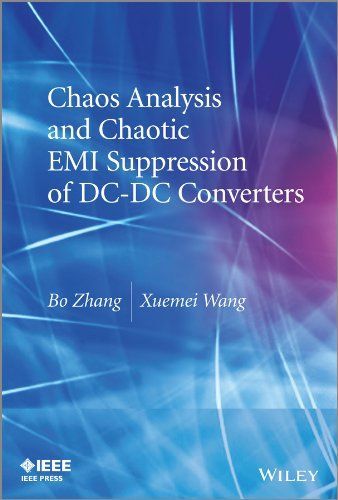
Chaos Analysis and Chaotic EMI Suppression of DC-DC Converters
Introduces chaos theory, its analytical methods and themeans to apply chaos to the switching power supplydesign DC-DC converters are typical switching systems which have plentyof nonlinear behaviors, such as bifurcation and chaos. Thenonlinear behaviors of DC-DC converters have been studied heavilyover the past 20 years, yet researchers are still unsure of thepractical application of bifurcations and chaos in switchingconverters. The electromagnetic interference (EMI), which resultedfrom the high rates of changes of voltage and current, has become amajor design criterion in DC-DC converters due to wide applicationsof various electronic devices in industry and daily life, and thequestion of how to reduce the annoying, harmful EMI has attractedmuch research interest. This book focuses on the analysis andapplication of chaos to reduce harmful EMI of DC-DC converters. After a review of the fundamentals of chaos behaviors of DC-DCconverters, the authors present some recent findings such asSymbolic Entropy, Complexity and Chaos Point Process, to analyzethe characters of chaotic DC-DC converters. Using these methods,the statistic characters of chaotic DC-DC converters are extractedand the foundations for the following researches of chaotic EMIsuppression are reinforced. The focus then transfers to estimatingthe power spectral density of chaotic PWM converters behind anintroduction of basic principles of spectrum analysis and chaoticPWM technique. Invariant Density, and Prony and Wavelet analysismethods are suggested for estimating the power spectral density ofchaotic PWM converters. Finally, some design-orientedapplications provide a good example of applying chaos theory inengineering practice, and illustrate the effectiveness onsuppressing EMI of the proposed chaotic PWM. Introduces chaos theory, its analytical methods and the meansto apply chaos to the switching power supply design Approaches the subject in a systematic manner from analyzingmethod, chaotic phenomenon and EMI characteristics, analyticalmethods for chaos, and applying chaos to reduce EMI(electromagnetic interference) Highlights advanced research work in the fields of statisticcharacters of nonlinear behaviors and chaotic PWM technology tosuppress EMI of switching converters Bridges the gap between numerical theory and real-worldapplications, enabling power electronics designers to both analyzethe effects of chaos and leverage these effects to reduce EMI